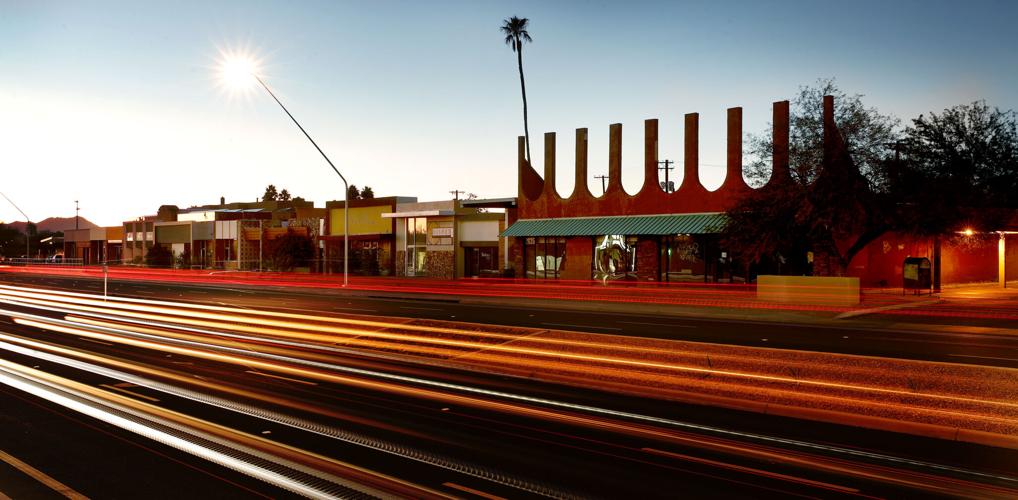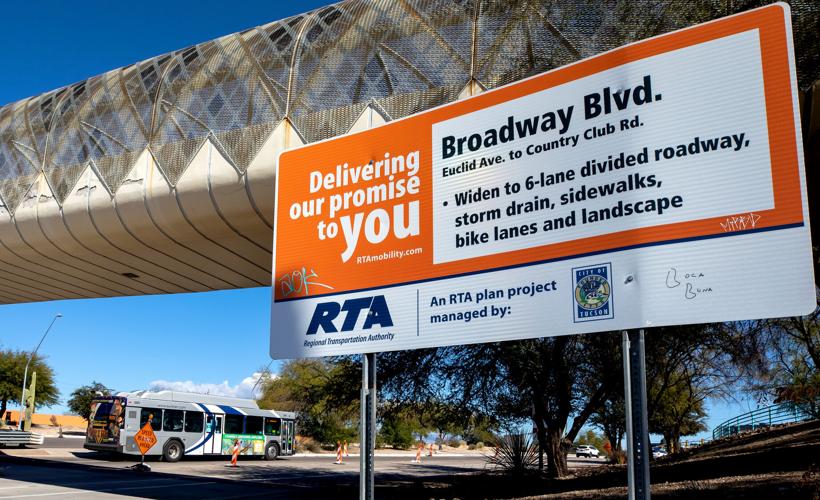Listening to the speeches at the reopening ceremony for the East Broadway reconstruction project on Thursday, you could be convinced by the vision.
The redevelopment plans for the Sunshine Mile — the two miles east of downtown Tucson between Euclid Avenue and Country Club Road — sound compelling.
Zemam’s, Tucson’s original Ethiopian restaurant, plans to expand the restaurant, add on an Ethiopian-style coffee and ice cream shop, a sports bar and an African Bazaar with revolving food stands in the back yard.
Developers Randi Dorman and Monique Lane plan to turn the bungalow block into a celebration of Tucson’s UNESCO City of Gastronomy status, complete with restaurants, bars, a teaching kitchen and other activities.
Now two local developers, Larsen Baker and Grant Krueger, are joining the redevelopment rush, working to turn the area along Broadway, between Euclid Avenue and Country Club Road, into an entertainment and food hub.
Larsen Baker is planning to convert the Solot Plaza into businesses serving neighborhood purposes, things like dog grooming or coffee shops. And Grant Krueger, of Union Hospitality Group, is planning to turn the Friedman block into a shopping center with restaurants, fitness businesses and boutiques.
All in all, it’s an inspiring vision. But it looks a little heavily dependent on the success of a series of new or expanded restaurants and food businesses, a notoriously difficult sector.
And the question that looms over the whole redevelopment of the Sunshine Mile remains: Where are all the customers going to come from?
The areas along Broadway — neighborhoods like Rincon Heights, Arroyo Chico, Broadmoor and Sam Hughes — may have enough money to support some business, but they are not particularly densely populated. They’re filled with single-family homes on sizable lots, like much of the development from that mid-20th century era.
The customer base would be easier to imagine if there were significant housing development planned along the Sunshine Mile, as there ought to be. It wouldn’t just benefit the redevelopment of that stretch but help address Tucson’s housing shortage.
Dense housing faced opposition
When the Rio Nuevo district got involved in redeveloping the Sunshine Mile, it proposed to the city of Tucson that tall, dense housing development be allowed along the road.
“We had significant height up and down Broadway,” said Fletcher McCusker, chair of the Rio Nuevo board. “We had it as high as 16 stories.”
The proposal ran into the typical form of Tucson resistance: Neighborhood objections. Residents of the neighborhoods along Broadway, to the north and south, protested that tall buildings would block their views, crowd neighboring homeowners, and create traffic and parking woes.
Meredith Aronson, who is on the board of the Broadmoor-Broadway Neighborhood Association, told me some neighborhood residents, herself included, were interested in dense development. But there were also strong opponents to dense housing development, people who wanted to keep the status quo.
“’Don’t change a thing, and don’t give us anymore density.’ That’s a very vocal part of the community,” she said.
A drawn-out negotiation ensued over changes to the city zoning for the area. In September 2021, the City Council approved the final Sunshine Mile Overlay District, which puts height limits of four stories in most areas, with six stories allowed if developers meet criteria involving such factors as parking or affordable housing.
Over to the west, near Euclid, the limit is seven stories. South of Safeway at Broadway and Campbell, there is the potential for a 12-story building.
In general, dense housing development will be limited. Height is limited, but so are potential sites. There are perhaps 6-10 sites for housing development in an area already well-developed and filled with historic buildings that can’t and shouldn’t be torn down.
“Primarily you’ll end up seeing that near the west end,” said City Council Member Steve Kozachik, who represents the area. “The east end is already pretty heavily built out from a residential perspective.”
Freddy’s Frozen Custard and Steakburgers, a fast-casual restaurant chain, already occupied one of the sites with a big-enough space for housing — the former El Parador site at 2744 E. Broadway.

A Regional Transport Authority sign for the Broadway Road Improvement project.
High costs, high interest
Even if they want to, developers will be hard-pressed to get projects built in the area. Art Wadlund, who developed the new buildings at 1 E. Broadway and 1 W. Broadway downtown, noted that the cost of construction and high interest rates make any apartment development a questionable prospect, especially if developers can put their money into easier-to-build and easier-to-maintain developments outside the urban core.
“The ones built downtown have been successful,” Wadlund told me Friday, “but it’s so expensive to build, so expensive to operate.”
Any developer could use subsidies, like the GPLET tax abatement program his buildings benefited from, but Rio Nuevo, which has helped so many center-city projects, is limited to helping ones that create sales tax. That’s its mission.
As a result, Sunshine Mile, unlike most commercial corridors in most cities around the world, won’t have enough residents nearby to support most businesses along it. Even this close to downtown, Tucson is just too thinly populated.
The new developments will largely depend on people coming from outside the surrounding neighborhoods in order to survive.
Parking deficit, transit solution
Amanuel Gegremariam, owner of Zemam’s, 2731 E. Broadway, told me he’s counting on outsiders making his expanded business a place to come and relax and enjoy themselves.
“It is going to be a destination for tourists, Tucsonans, families with children. A center for Tucsonans,” he said.
Zemam’s has planned for the biggest challenge in the area — parking. This project will have parking further to the west.
But overall, parking is limited along the Sunshine Mile, by design. The widening of Broadway eliminated many parking lots in the front of buildings, leaving a more attractive commercial street but a deficit of places to leave cars for the majority of Tucsonans who drive to get around.
The city is considering a rapid-transit bus line along Broadway, and Rio Nuevo is studying an open-air trolley bus, which could run from downtown as far east as Park Place Mall. Light rail, or a new streetcar, could potentially fit on the widened Broadway, but there was no money to build it, unlike the downtown streetcar that was built with a big federal grant.
So the Sunshine Mile has great potential, but due to Tucson’s particular laws and traditions discouraging dense development, not enough people to fulfill it yet. Some day, I believe, this will change, but it will take more openness to a different type of city living than predominates now.
Tim Steller is an opinion columnist. A 25-year veteran of reporting and editing, he digs into issues and stories that matter in the Tucson area, reports the results and tells you his conclusions. Contact him at tsteller@tucson.com or 520-807-7789. On Twitter: @senyorreporter






